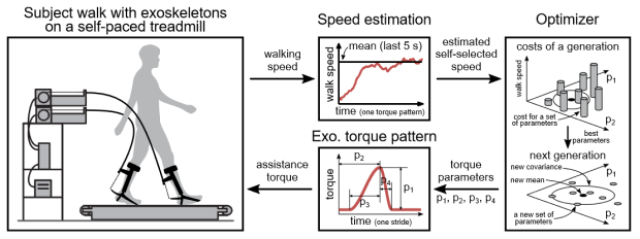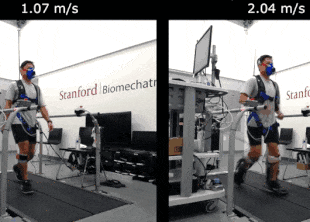American engineers have taught the exoskeleton for the legs to increase the walking speed by an average of 42 percent. After the start of walking, the exoskeleton gradually optimizes the parameters of its work, adapting to the walking of a particular person. The article is published in the journal IEEE Transactions on Neural Systems and Rehabilitation Engineering.
Most often, an exoskeleton is a design that is put on the entire body and enhances its functions, for example, allowing you to lift very heavy objects without much effort. But in fact, there are many different directions in the field of exoskeletons, focused on certain parts of the body, including the legs. Among them, we can distinguish both passive exoskeletons that help a person due to the mechanical properties of the structure, and active ones that move his legs with the help of electric motors or other actuators.
Typically, leg exoskeleton designers focus on reducing the metabolic costs of walking or running, which allows a person to get less tired. Son Moon Song (Seungmoon Song) and Steven Collins (Steven Collins) decided to use the exoskeleton legs in a different way — to increase the speed of walking. They used an exoskeleton and a stand created by a group of engineers led by Collins in 2015. The exoskeleton has a classic design for such devices. It is attached to the lower leg and foot, and these two parts are connected by a rope, the tension of which allows you to change the angle between the ankle and the lower leg. This in turn significantly affects the parameters of walking or running.
In addition to the exoskeleton itself, the authors also used a treadmill and a stand that allows you to pull ropes and set walking parameters. The track automatically changed its speed, adjusting to the speed of the subject. In parallel, the parameters of the exoskeleton changed. To do this, the authors used the evolutionary optimization algorithm CMA-ES, which is often used for such problems, which starts with random parameters, and then selects the best parameters that increase the target parameter (in this case, increase the walking speed of the subject). Thus, it gradually selects the optimal mode of operation for each individual person, without requiring complex manual selection from engineers.

Exoskeleton parameters optimization scheme
Image source: Seungmoon Song, Steven Collins et al. / IEEE Transactions on Neural Systems and Rehabilitation Engineering, 2021
The authors selected ten volunteers of different sexes, who then participated in the experiment for three days (the experiments did not take place every day, but after 1-3 days, to eliminate fatigue from long walking). Their task was to walk on the treadmill at a comfortable speed for 72 minutes, during which the parameters were optimized. After optimization, the volunteers walked ten times for two minutes in different conditions: with the exoskeleton on and on, with the exoskeleton on and off, and without the exoskeleton in normal sneakers.
Experiments showed that the average walking speed in sneakers was 1.31 meters per second, 1.27 meters per second with the exoskeleton turned off, and 1.83 meters per second with the exoskeleton turned on. Thus, the optimized exoskeleton increased the walking of the volunteers by an average of 42 percent. The authors also calculated the metabolic costs of walking, but the results were mixed: on average, the exoskeleton reduced costs by two percent, but in individual subjects they increased by 78 percent and decreased by 31 percent, so it is impossible to draw clear conclusions about the impact of the exoskeleton on costs with such a sample.
One of the disadvantages of the exoskeleton used in this work is that it is paired with a stationary stand, so it can only be used for research. But there are also compact exoskeletons that are attached to the ankle, which can be worn in everyday life and hidden under the pant leg.
Grigory Kopiev

